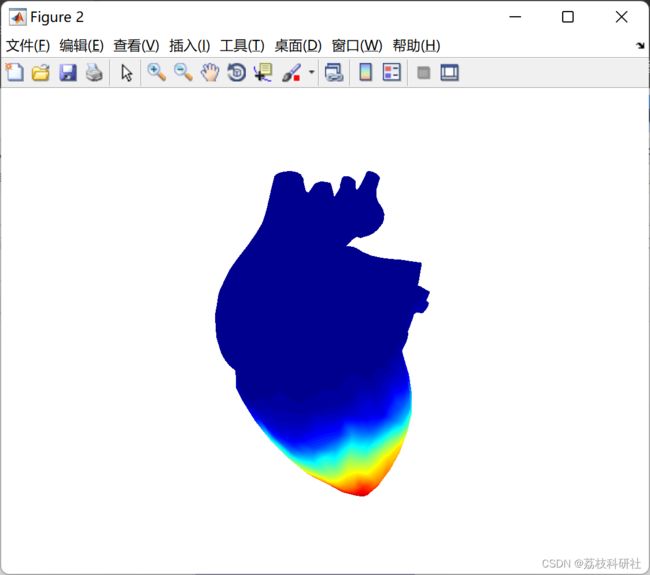【元胞自动机】模拟电波在整个心脏中的传导和传播的时空动力学研究(Matlab代码实现)
个人主页:研学社的博客
欢迎来到本博客❤️❤️
博主优势:博客内容尽量做到思维缜密,逻辑清晰,为了方便读者。
⛳️座右铭:行百里者,半于九十。
本文目录如下:
目录
1 概述
2 运行结果
3 Matlab代码+数据+详细文章讲解
4 参考文献
1 概述
文献来源:
心脏电活动在空间和时间上都有所不同。人类心脏由肌肉细胞、浦肯野纤维、动脉和静脉组成的分形网络组成。电波传导和传播的全心建模涉及更高的复杂性。我们之前的工作开发了解剖学上逼真的心脏的计算机模型,并使用细胞自动机和并行计算模拟了电传导。然而,由于非线性动力系统对初始条件的敏感依赖性,简单的假设和规则限制了其在复杂心脏表面上提供真实世界动力学的准确近似的能力。在本文中,我们提出了新的反应扩散方法和模式识别工具来模拟和模拟电波在复杂心脏表面传导和传播的时空动力学,其中包括(i)全心脏模型;(二) 三维心脏几何形状的二维等距图;(iii)二维图中电波的反应扩散建模,以及(iv)时空模式识别。实验结果表明,所提出的数值解具有较强的模拟全心脏电波传导时空动力学的潜力,从而更好地理解疾病改变的心脏机制。
工程和自然系统通常涉及不规则和自相似的几何形式,称为分形几何。例如,精密加工会产生一个视觉上平坦的表面,而在显微镜下,它看起来就像一座纳米级的粗糙山。人类心脏由肌肉细胞、浦肯野纤维、动脉和静脉组成的分形网络组成。心脏电活动表现出高度非线性和分形行为。尽管时空动力学发生在分形几何上,例如,机械加工零件表面的化学蚀刻和心脏的导电,但大多数现有工作都是在欧几里得几何(例如,平面和矩形体积)上模拟时空动力学(例如,反应、扩散和传播)。由于非线性动力学系统对初始条件的敏感依赖,这带来了真实世界动力学的不精确近似。在本文中,我们开发了复杂系统分形表面上时空动力学的数值模拟和模式识别的新方法和工具,包括(1)分形几何的表征和建模,(2)基于分形的时空动力学模拟和建模,以及(3)识别和量化时空模式。实验结果表明,所提出的方法优于基于欧氏几何的传统建模方法,为复杂系统分形表面上的时空动力学建模和表征提供了有效工具。
2 运行结果
部分代码:
clear all;
close all;
clc;
%% read heart data
load Heart.mat
tri = Heart.tri;
X_data = Heart.X_data;
figure('color','w')
trisurf(tri,X_data(1,:),X_data(2,:),X_data(3,:));
set(gca,'Cameraposition',[121.9479 -102.7107 198.4202]);
colormap([1,0,0]);
lighting phong
alpha(.35);
shading interp;
axis equal off tight;
%% isometric graphing
% % the isometric graphing takes sometime for a large dataset, you can load
% % the mapped surface data directly
% D = squareform(pdist(X_data')); % pairwise distance matrix
% options.dims = 2; % reduced dimensionality
% % options.display = 0;
% [Z,W,E] = Isomap(D,'k',4,options);
load Z_heart.mat
%% reaction-diffusion modeling
index = Z.index;
p = Z.coords{1}; % coordinates of 2d surface
t = delaunay(p(1,:)',p(2,:)'); % delaunay triangulation of surface
% % stimulus = which kind of stimulation protocol is used
% % 'one' = S1 protocol; 'two' = S1-S2 protocol
% % 'hea' = healthy heart; 'arr' = heart with arrhythmia
para = [0.13,0.013,0.26,0.1,1.0,0.1]; % FHN model parameters
deltaT = 0.15; % time-step delta T
N = 8000; % total time steps
% % Plot without output
reaction_diffusion(p,t,X_data,'hea',para,deltaT,N,index,tri);
% U = reaction_diffusion(p,t,X_data,'hea',para,deltaT,N,index,tri);
3 Matlab代码+数据+详细文章讲解
4 参考文献
部分理论来源于网络,如有侵权请联系删除。
[1]Hui Yang (2022). Simulating spatiotemporal dynamics in the whole heart
[2]Chen, Yun, and Hui Yang. “Numerical Simulation and Pattern Characterization of Nonlinear Spatiotemporal Dynamics on Fractal Surfaces for the Whole-Heart Modeling Applications.” The European Physical Journal B, vol. 89, no. 8, Springer Science and Business Media LLC, Aug. 2016, doi:10.1140/epjb/e2016-60960-6.
[3]Yang, Hui, et al. “Whole Heart Modeling — Spatiotemporal Dynamics of Electrical Wave Conduction and Propagation.” 2016 38th Annual International Conference of the IEEE Engineering in Medicine and Biology Society (EMBC), IEEE, 2016, doi:10.1109/embc.2016.7591990.


